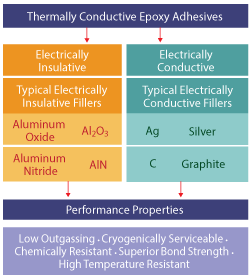The market is demanding all sorts of optical and electronic systems for military, aerospace, communications and consumer systems. These systems rely on high-power semiconductors, diodes, converters, amplifiers, radio devices, antennas, high frequency ID tags and optoelectronics devices. Electronics fabrication and assembly typically requires the use of adhesives, die-attach compounds, glob-top encapsulants, underfills and potting compounds. Since many materials exist, engineers should be familiar with how the material affects design performance. In the following discussion, we examine the unique requirements high-power and high frequency communications electronics place on adhesives and encapsulants, as well as the material characteristics needed to satisfy performance objectives.
MANAGING THERMAL PERFORMANCE
To dissipate the heat that can degrade device performance and transfer heat across components, many designs use heat sinks combined with other cooling methods and technologies. These techniques often require thermal adhesives and potting compounds that exhibit excellent thermal conductivity and provide good structural integrity. Thermally conductive adhesives or potting compounds aid in transferring heat from the electronics to the heat sink or other cooling system that dissipates it. This reduces the thermal load on these components, especially useful when there are many heat-sensitive components.
Thermally conductive adhesives can either be electrically conductive, act as insulators or provide electromagnetic shielding, driven by the specific application requirements. The die attach of a high-power semiconductor application may need either an electrically conductive or an electrically insulative die attach. Typically, an extremely fast cure at temperatures from 125°C to 200°C is also desirable. On the other hand, a high frequency application such as an antenna system may need an adhesive that shields against electromagnetic interference (EMI). Often, a conductive coating is applied to housings to provide the desired shielding, even at extremely high frequencies, e.g., to 18 GHz. In these cases there is similarity in the thermal properties, because most of these applications have high heat dissipation. In applications where electrical insulation is necessary, high volume resistivity and high dielectric strength are often prerequisites.1

Figure 1 Insulative and conductive adhesives.
ADHESIVES
Many adhesive chemistries are available today, such as epoxies, silicones, polyurethane and polysulfide-based materials. Typically, the bulk thermal conductivities for these systems falls in the 0.1 to 0.2 W/(m•K) range, essentially making them behave as thermal insulators. To make these materials transfer heat, i.e., act as heat dissipaters, various fillers can be used depending on the application. Fillers play the critical role of increasing the thermal conductivity of these chemical systems. Potentially, the thermal conductivity can be increased by 10 to more than 20×, depending on the type of filler and the chemistry used to blend the filler. A few examples of fillers are aluminum oxide, aluminum nitride and silver and graphite based fillers (see Figure 1). Aluminum oxide and aluminum nitride increase thermal conductivity while providing electrical insulation. Silver and graphite based fillers boost heat conduction while providing electrical conductivity. The material surrounding the filler prevents oxygen penetration and the formation of oxides. The compounds are formulated and mixed in a way that ensures air is not entrapped and voids are minimized, to give maximum particle-to-particle contact and maximize the surface area. This ensures the best thermal conductivity performance, as well as either electrical conductivity or insulation.
The particle size of the filler has a significant impact on the thickness of the bond line that can be achieved, which plays an important role in realizing good heat transfer. The particle size of standard fillers may be 40, 50 or 100 µm. On the other hand, it is possible to create fillers with maximum particle sizes of 10 to 15 µm and average sizes of 2 to 3 µm. In R&D labs, technologists are experimenting with fillers containing nano-sized particles. To understand the impact of particle size, consider two thermally conductive epoxies with the same thermal conductivity, say 1.0 W/(m*K) and both with an aluminum oxide filler. The only difference between the two is the maximum particle size of their fillers; one has particles 50 µm or smaller, the other 10 µm or smaller. Even though the bulk thermal conductivity of both fillers is the same, the epoxy with 10 µm size particles can achieve much thinner bond lines—theoretically about 20 percent the thickness of the 50 µm fille—resulting in higher heat transfer and lower thermal resistance.
